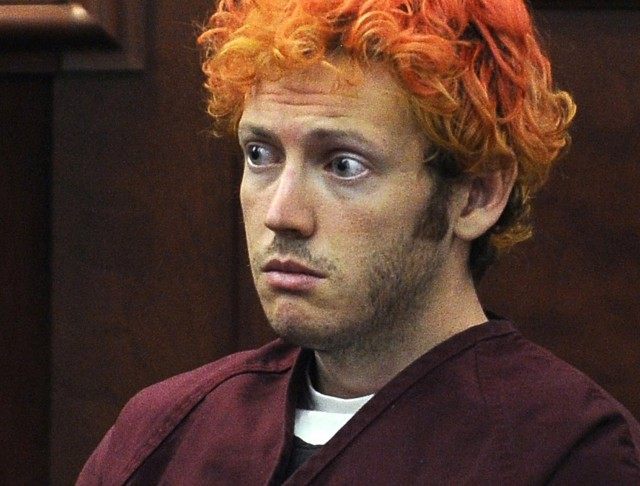CENTENNIAL, Colo. (AP) — Jurors convicted Colorado theater shooter James Holmes on Thursday in the chilling 2012 attack on defenseless moviegoers at a midnight Batman premiere, rejecting defense arguments that the former graduate student was insane and driven to murder by delusions.
The 27-year-old Holmes, who had been working toward his Ph.D. in neuroscience, could get the death penalty for the massacre that left 12 people dead and dozens of others wounded.
Jurors took about 13 hours over a day and a half to review all 165 charges. The same panel must now decide whether Holmes should pay with his life.
The verdict came almost three years after Holmes, dressed head-to-toe in body armor, slipped through the emergency exit of the darkened theater in suburban Denver and replaced the Hollywood violence of the movie “The Dark Knight Rises” with real human carnage.
His victims included two active-duty servicemen, a single mom, a man celebrating his 27th birthday and an aspiring broadcaster who had survived a mall shooting in Toronto. Several died shielding friends or loved ones.
The trial offered a rare glimpse into the mind of a mass shooter, as most are killed by police, kill themselves or plead guilty.
Prosecutors argued Holmes knew exactly what he was doing when he methodically gunned down strangers in the stadium-style theater, taking aim at those who fled. They painted him as a calculated killer who sought to assuage his failures in school and romance with a mass murder that he believed would increase his personal worth.
He snapped photos of himself with fiery orange hair and scrawled his plans for the massacre in a spiral notebook he sent his university psychiatrist just hours before the attack, all in a calculated effort to be remembered, prosecutors said.
The prosecution called more than 200 witnesses over two months, more than 70 of them survivors, including some who were missing limbs and using wheelchairs. They recalled the panic to escape the black-clad gunman.
The youngest to die was a 6-year-old girl whose mother also suffered a miscarriage and was paralyzed in the attack. Another woman who was nine months pregnant at the time described her agonizing decision to leave her wounded husband behind in the theater to save their baby. She later gave birth in the same hospital where he was in a coma. He can no longer walk and has trouble talking.
That Holmes was the lone gunman was never in doubt. He was arrested in the parking lot as survivors were still fleeing, and he warned police he had rigged his nearby apartment into a potentially lethal booby trap, which he hoped would divert first responders from the theater.
His attorneys argued he suffers from schizophrenia and was in the grip of a psychotic breakdown so severe that he was unable to tell right from wrong – Colorado’s standard for insanity. They said he was delusional even as he secretively acquired the three murder weapons – a shotgun, a handgun and an AR-15 rifle – while concealing his plans from friends and two worried psychiatrists in the months before the shooting.
Defense lawyers tried to present him as a once-promising student so crippled by mental illness that he couldn’t reveal his struggles to anyone who might have helped. They called two psychiatrists, including a nationally known schizophrenia expert, who concluded Holmes was psychotic and legally insane.
But two state-appointed doctors found otherwise, testifying for prosecutors that no matter what Holmes’ mental state was that night, he knew what he was doing was wrong.
Jurors watched nearly 22 hours of videotaped interviews showing Holmes talking in a flat, mechanical tone about his desire to kill strangers to increase his self-worth. Using short, reluctant answers, he said he felt nothing as he fired, blasting techno music through his earphones to drown out his victims’ screams.
Prosecutors showed jurors Holmes’ spiral notebook, where he scribbled a self-diagnosis of his “broken mind” and described his “obsession to kill” since childhood. The pages alternate between incoherent ramblings and elaborate plans for the killings, including lists of weapons to buy and diagrams showing which auditoriums in the theater complex would allow for the most casualties.
Jurors saw an investigator’s video of the shooting’s aftermath. It showed bodies wedged between rows of seats and sprawled across aisles amid spent ammunition, spilled popcorn and blood.
During the sentencing phase, Holmes’ attorneys will present so-called mitigating factors that they hope will save his life. Those will probably include more evidence of mental illness and a sympathetic portrayal of his childhood. Prosecutors will present so-called aggravating factors in support of the death penalty, including the large number of victims.

COMMENTS
Please let us know if you're having issues with commenting.